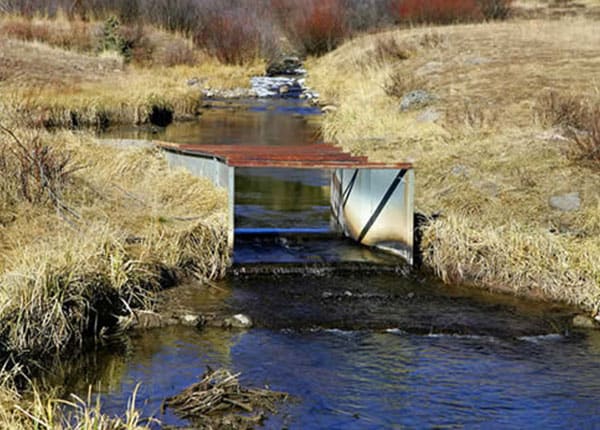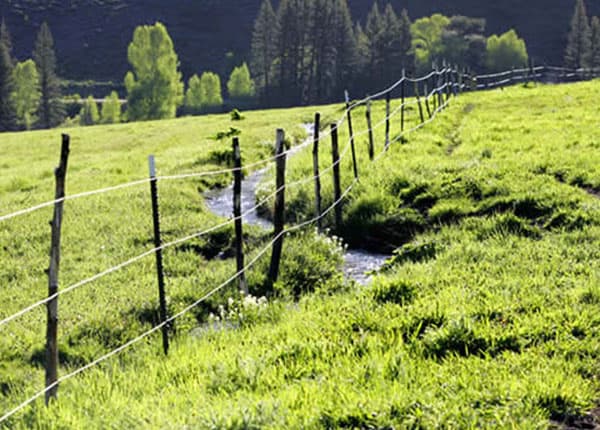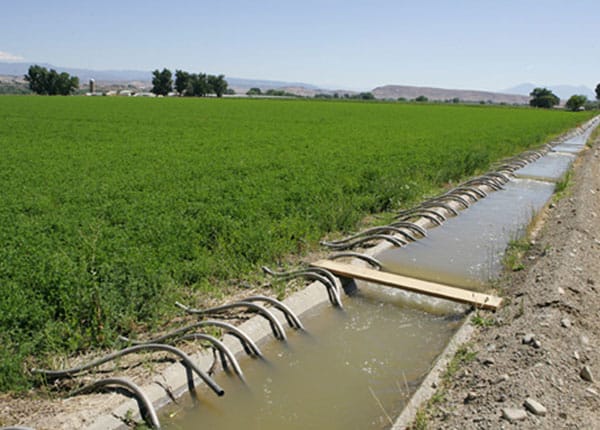A Beginner’s Guide
©Gary Hubbell 2007, 2014. All photos and text by Gary Hubbell. All rights reserved. This article and the photographs may not be reproduced without the express written consent of the author.
For many ranch real estate buyers, the dream of owning a western ranch is an idyllic life where the grass is always green, the skies are always blue, and there’s never a mud season. Well, that’s just not always the case. There’s a great deal of hard work involved in keeping Western ranches green and productive. The mountain West is very arid, and some areas receive less than 15 inches of precipitation yearly. In most cases, growing crops on a ranch involves irrigating, which means diverting water from a stream, river, reservoir, or aquifer, and delivering it somehow to a thirsty hayfield, pasture, or crop field.
The Beginnings of Irrigation Systems in the West
In most Western ranch settings, water is delivered to agricultural properties by gravity-fed systems. Simply put, the water source is uphill from the field it irrigates. The most basic irrigation systems are a network of ditches constructed in the late 19th century with very rudimentary tools. These ditch systems were constructed with horse-drawn plows and men moving rocks by hand and pick and shovel. With a lot of sweat and hard work, they turned many a dry sagebrush flat into a productive green hayfield over time. In Western Colorado, many of these systems were built immediately after the territory was settled in the 1880’s.
Water rights are deeded rights, and sometimes can be separated from the property. It is a complex area of the law, and is the subject of much debate, discussion, argument, and yes, lawsuits. If you’re considering buying a cattle ranch, I strongly recommend having a good water attorney review the water rights on any property you may consider purchasing.
How Water Is Measured
A man named Ralph Parshall (after whom the town of Parshall is named) invented a device in 1922 that accurately measures how much water flows into a ditch. Called a Parshall Flume, it’s a metal box with a wide mouth at each end. A scale, or “staffing gauge”, measures how much water is flowing through the box, and consequently the volume of water can be calculated. Parshall flumes are pricey at over $800 for a medium-sized flume, and tricky to install. It’s important that the flume is set level and set so that the water flowing into it doesn’t drop significantly. When a flume has a gentle, steady flow across it, the readings are more accurate. Legally, readings from a Parshall flume aren’t considered accurate unless there is a “stilling basin”, or a place for the water to calm itself before flowing into and out of the flume.


This Parshall flume measures the flow of a mountain stream into a reservoir.
Water is measured in several different ways:
CFS: “cubic feet per second,” or CFS, is equivalent to 440 gallons per minute. A rule of thumb in Colorado is that 1 CFS is capable of irrigating between 40 and 80 acres of hayfield. A ranch with 2.2 CFS of water rights, for example, may have plenty of water to irrigate over 100 acres of hay. Of course, this is extremely variable for each property and each situation has to be apprised separately.
ACRE FEET: While cubic feet per second measures the amount of water that is flowing down a stream or ditch, “acre feet” measures the amount of water in a reservoir BEFORE it is delivered to a property. Simply put, one acre foot is enough water to cover one acre a foot deep. Two acre feet is roughly equivalent to 1 CFS flowing for a 24-hour period. So, if your property has a reservoir water right, you could order a defined amount of water to be delivered to your property to grow your crop. In my case, my ranch has 140 acre-feet of water. Later in the summer, I order 2 acre feet a day of reservoir water to get through the irrigation season. That means I can deliver 1 CFS a day for 70 days.
GALLONS PER MINUTE: This unit of measurement often is used with irrigation wells and pumps, because water can be easily metered through irrigation pipes. Often you’ll see farm properties listed with water rights such as “1,340-GPM center pivot”.
INCHES: No matter how water is delivered, it all comes down to how many inches of precipitation are delivered to a crop. Alfalfa, for example, typically requires between 31-36″ of water to grow a good crop. If the natural precipitation in a local area is 10″, that means the crop must receive about 24″ of water to grow a good crop. That water can be delivered in many different ways, but without the entire amount of water, it won’t grow well. A good center pivot sprinkler, for example, can deliver 2-3″ of water in a single pass, making it a very efficient method of irrigating a crop. In 10-12 passes over the growing season, the crop will receive enough water to grow. The same amount of water can be delivered by flood irrigation, but it might take a lot more effort and time to accomplish the same task, with a lot of waste as well.
Ditch companies or irrigation companies often serve broad expanses of land made up of many different separately owned parcels. For example, let’s say the Big Pine irrigation company has rights to 50 cubic feet per second of water from Beaver Creek. The ditch company has issued 1,000 shares of stock. You’re looking at buying a ranch with 25 shares of the Big Pine Ditch. Is that enough to irrigate 100 acres of hay? That works out to be 1.25 CFS, or about 600 gallons per minute. The sprinklers on my property require 800 gallons a minute to irrigate 110 acres, so I think you would be light on water if you wanted to irrigate the entire property. EACH DITCH COMPANY IS DIFFERENT, and how much water is delivered to your property can vary widely. Ten shares of one ditch could be a lot of water. Ten shares of another irrigation company could be very little water. It all has to do with the volume of water.
Take note, also, that irrigation flows fluctuate. In a year with a big snowpack and a lot of spring runoff, you may actually get much more water than your water rights provide for. Later that summer, it may dry up entirely. In a dry year, you may see only a portion of the water to which you’re legally entitled. It may be that there just isn’t water in the creek, and the reservoir may be too low to deliver reservoir water.
Who Decides How You Get Your Water?
The apportionment of Colorado irrigation water is overseen by a local water commissioner, under the auspices of the Colorado state government. The water commissioner makes sure that no one is taking more water than they’re allotted, and that water law is followed. Often water commissioners physically inspect diversions from streams and headgates of ditches to make sure they’re properly set. Usually each individual ditch company has its own “ditch rider” on staff, a person who is hired to drive or walk and inspect the ditch, perform necessary maintenance, and set irrigation dividers to send water to each individual property owner. While for some people it can get confusing as to how much water goes where, it really is a matter of fairly basic mathematics. If you have a question about your irrigation water or you think you aren’t getting your fair share, ask for a conference with the ditch rider and the water commissioner.
Whiskey’s for Drinkin’ — and Water Is for Fightin’!
One of the biggest sources of contention with neighbors is water usage. Headgates, valves, dividers, and so forth are usually set by a (hopefully) impartial ditch company employee (often called the “ditch rider”) or even the water commissioner. The best way to get in a real old-fashioned nasty dispute is to start tampering with ditch dividers and settings. When people haven’t grown up with irrigation systems, they often don’t understand the intricate nature of the flows and settings. Without realizing they’re doing something wrong, they’ll open a divider to send more water down their ditch, starting an instant dispute or confrontation. Let me give you an example. My friend, let’s call him Jim, owns 40 acres with a good water right. His upstream neighbor came from Denver and bought the acreage next door, which had an old pond on it. Without asking, each spring the neighbor would open up a headgate and fill his pond, which would take a week or so. In the meanwhile, Jim was out of water during a critical time of the year. After a couple of years and fairly polite requests not to steal his water, Jim called the sheriff. The deputies wanted nothing to do with the fight, saying it was a civil situation. Jim broke out the Colorado Revised Statutes and insisted that his neighbor be prosecuted for theft, and sure enough, after all the dust settled, his neighbor spent a week in jail. He doesn’t steal water anymore.
Ranch Work Is Hard Work
Most people don’t realize that irrigation is one of the biggest jobs of running a Western agricultural property. My wife and I own 116 acres of irrigated land. In the spring, it takes up to four hours a day to finish the irrigation, simply because of the sheer volume of water. As the flows taper off later in the season, it takes 1 ½ to 2 hours a day to irrigate. It must be done every day.

Irrigating is a peaceful job that offers a good amount of exercise, and it’s best done with a canine companion.
In an emergency, you can let the water flow in the same spot in the field two or three days in a row, but you run the risk of over-saturating the soil and damaging your crops. On a ranch with 300 acres of hay, it could take one man all day, every day, to properly irrigate the place, though he may be able to do it in half that time if he’s skilled and the systems are in good condition.
Flood Irrigation
Many western ranches are still irrigated with flood irrigation. In its most basic form, flood irrigation means that greening up the fields is a simple matter of damming up a flowing ditch and diverting the water onto the field. Once you water that section of field, you move the dam down the ditch and flood a different section of the field. Many other societies have irrigated in this manner, beginning with the ancient Sumerians and on to the Mayans, the Anasazi, and many other ancient cultures. As you can imagine, it’s not a very sophisticated system.

This is a typical Colorado mountain ditch irrigating 40 acres of horse meadow near Marble, Colorado.
The advantages of a flood irrigation system are that it’s usually already in place if you have water rights to your property; it’s cheap, because gravity requires no other energy source; and there are few, if any, moving parts to maintain. Your irrigating tools consist of an irrigating shovel, an irrigating tarp to place in the ditch, and some rocks to hold it down.
The disadvantages of a flood irrigation ditch are that it’s labor-intensive and relatively slow to accomplish; ditches clog up and must be dredged out with a backhoe; it wastes a lot of water; and, in a bigger picture, unlined ditches contribute to salinity downstream.
Gated Pipe Irrigation System

Yippee! The government is going to help pay to upgrade my irrigation system? Yes, there are programs available to help with the cost of upgrading irrigation systems. Check with the NRCS (Natural Resources Conservation Service) to see if your property is eligible. One method of eliminating earthen ditches is to install gated polyethylene pipe. The water is delivered into the pipe via a “vibrating screen”, a concrete box with a tight screen that keeps sticks, leaves, and other trash from entering the system. Replacing main ditches that irrigate large fields, the pipe can be up to 15 inches in diameter and deliver quite a volume of water. In smaller fields, the pipe is as small as 4” in diameter. The pipe is slotted every two feet with “gates”—plastic slides about the size of a pack of cigarettes—that can be opened and closed to irrigate fields. Gated pipe makes irrigating chores much easier. You just walk along the pipe and tap the gates open or closed with an irrigating shovel to flood the field below you. Of course, there may be rises or dips in the topography of your field, and you may have to cut some laterals in your field to guide water onto ridges that would be hard to reach otherwise.
The pros and cons of gated pipe irrigation systems:
Advantages: efficient, effective way to flood irrigate gently sloping fields. Not labor-intensive. Easy to use. A 10-year-old child can effectively and quickly irrigate with gated pipe.
Disadvantages: If there are great variations in your terrain, gated pipe is not the best solution. Fields must be fairly regular. Requires reliable delivery system, such as a concrete distribution box. Expensive to install, but the government will pay much of the cost.
Side-roll Irrigation System
Side-roll irrigations systems are popular with people who have large, rectangular, fairly flat fields to irrigate. Rather than flooding a field with water, these systems are built of large aluminum wheels that hold a pipe full of water off the ground. The pipe is studded with sprinklers at regular intervals, which sprinkle the ground with water. The side-roll system is equipped with a small motor and a gear mechanism in the middle. To move the system, the operator drains the pipe, starts the gas motor, and wheels it forward until he reaches dry ground. He then re-charges the system with water and starts it up again. The system is fed by a series of underground pipes that are filled under a vibrating screen at a central concrete distribution box.

This side-roll sprinkler irrigates a hayfield on a cattle ranch near Crawford, Colorado
The pros and cons of side-roll irrigation systems:
Advantages: even, consistent irrigation system that completely covers a field. Has some ability to cover hilly terrain, and can irrigate dry patches that flood irrigation sometimes can’t reach. A reliable system. Doesn’t require much “head”, or gravity pressure, to operate. Government will often assist in design, construction, and cost sharing.
Disadvantages: Labor-intensive. Must be moved at least once a day, every day, throughout the irrigation season. Can sometimes be hard to move. If you don’t know what you’re doing, you can wreck the system and kink expensive aluminum pipes. Sometimes takes up to a month or more to cover a field. By the time you cover the field once, the place where you began can be burning up. Sometimes pests can take over, such as groundhogs or prairie dogs, because the ground isn’t flooded. Expensive to purchase and install. Must be shut off while you change the water. If you change the water twice a day and it takes an hour each time, you lose 1/12 of your water downstream. Requires an engineered delivery system such as a distribution box and vibrating screen, and often requires underground pipes to deliver the water to the system.
Center Pivot Irrigation System
Pivot irrigation systems are denoted by the circles of irrigated crops that you see from an airplane, where the circle is the irrigated area and the triangles of the square are either weeds or dryland crops. Similar to a side roll system, center pivot systems are composed of links of aluminum pipe set on wheels high above the ground. The pipe feeds a set of sprinklers spaced evenly along the pipe. Can be used to irrigate fields as large as 160 acres (1/4 of a square mile!) Most often, these are irrigation systems that are fed by wells tapped into underground aquifers and powered by natural gas, gasoline, or electric motors. Occasionally you’ll see these systems in mountain ranch country, fed by gravity flow irrigation water, but most often center pivot systems are found in flatter plains areas where water is pumped from underground. Center pivot systems are easy to use in flat areas where fields are regular square sizes, but you’ll see more and more of them as you travel the West. Center pivots have a distinct advantage over side-roll systems in that they can cover an entire acreage in 24-48 hours, whereas it might take 2-3 weeks to cover the same ground with a side-roll. Farmers who have installed center pivots will tell you that their hay yields have doubled or even tripled over traditional flood irrigation methods. While side-roll systems are very labor-intensive, requiring a farmer to physically move the sprinkler at least once a day, center pivots are easy to operate, requiring only flipping a couple of switches. Some folks even configure their center pivots so they can operate them off their cell phones.

Center pivot irrigation systems are usually found in the plains states, where water is pumped from underground aquifers. Occasionally you’ll see them on mountain cattle ranches in Colorado, where gravity-fed systems prevail.
Pros and cons of center pivot irrigations systems:
Advantages: reliable, consistent means of irrigating crop fields. Typically used for corn, alfalfa, and sometimes grain crops like wheat and barley. Good, consistent coverage of crop areas. Uses water very efficiently. Installation often results in 3x better hay or crop production compared to previous systems. Configured with a low-pressure gravity system, can be extremely energy-efficient, but requires fields with fairly gentle topographical changes. Government will often assist in design, construction, and cost sharing.
Disadvantages: expensive to install. Typically requires an expensive electric well pump to power the system. “Circle in a square” configuration leaves corners dry and un-irrigated. Requires engineered delivery system. The mechanisms are complex, and when they break down, can require expensive repairs. Can sometimes get stuck or bogged down.
Concrete Ditch or Siphon Irrigating System
In a nod to efficient irrigating and decreased salinity, some farmers have invested heavily in concrete ditch irrigating systems. This is a very effective system for farmers who have flat, straight fields and clearly defined fields with enough elevation change so that water moves from one end to the other of the field. The farmer lays his fields out in squares and pours a concrete ditch on the uphill side of his fields. The irrigation water is delivered into the ditch, whereupon the farmer places a series of bent siphon tubes into the ditch. When the farmer drops a dam into the ditch, the siphons fill up and pump water into the row crops. This is a great system for irrigating flat, gently sloping land with flood irrigation, and is often used for row crops like corn, onions, and beans, and often used for alfalfa fields as well. Though the concrete ditch system is frequently seen in Colorado, it’s used in more of a flatland farm setting in lower elevations. It’s rarely seen in mountain ranch settings.

Pros and cons of concrete ditch system:
Advantages: reduces salinity by eliminating earthen bank ditches. Easy to use, easy to change the irrigation settings. Delivers a lot of water quickly to crops. Large portions of fields can be flooded quickly in one day. Government will often assist in design, construction, and cost sharing.
Disadvantages: really, this system only works in row crop settings on very gently sloping land. You will not see this system on mountain fields and pastures. Concrete is very expensive to install, and very permanent. Cannot be moved to another field. Uses quite a lot of water—far more than a typical side-roll or center pivot system. Needs an engineered system to reliably deliver water to the ditches. As center pivot systems become more popular, you will see fewer and fewer concrete ditch/siphon irrigation systems.
Big Gun Sprinklers
“Big gun” sprinklers are another way to irrigate hard-to-reach parts of a property. These are sprinklers that are pressurized either by gravity or a pump, and require underground pipe to run water to them. They can often be used in tandem with center pivots, side-roll sprinklers, or other irrigation methods. Every 100 feet or so, a riser will stick up out of the ground so the farmer can hook on to the water source, and they can be moved fairly easily. They look like a small cannon, except instead of a cannon barrel, they have a big sprinkler head. The radius of a big-gun sprinkler is often 100 feet or more, so they cover a lot of ground. Of course, they spray in a circular pattern, so there are overlaps or missed spots, depending on the configuration, and when the grass gets tall, they can be hard to move. They shoot out a lot of water, and when big drops of water travel that far, they tend to land hard and spatter, causing soil compaction. Big guns can be an excellent way to cover hard-to-reach parts of a field.
Decision Time — What Kind of Irrigation System Will You Install?
So this begs the question: what kind of farmer or rancher do you want to be? If you plan to raise hay, and therefore cattle, horses, or other livestock in Colorado, how do you plan to irrigate your fields?
MY PERSONAL CHOICE IS CENTER PIVOT IRRIGATION SYSTEMS. CALL ME FOR MORE INFORMATION, 970 988 2122, OR EMAIL ME. I CAN RECOMMEND GOOD CONTRACTORS TO INSTALL CENTER PIVOT SYSTEMS AND HELP WALK YOU THROUGH THE PROCESS OF APPLYING FOR NRCS GRANTS. LET ME KNOW IF YOU NEED MY HELP IN CONSULTING WITH YOU. THIS IS PART OF WHAT WE DO WITH OUR RANCH PROPERTY MANAGEMENT COMPANY.
If you’re considering the purchase of a piece of farm or ranch property, it makes real sense to analyze what kind of irrigation system is present on the property. Earthen ditches for flood irrigation that were dug over 100 years ago are effective, but labor-intensive, inefficient, and crude. If a farmer or rancher has installed an efficient center pivot or side roll system, that adds a fair amount of value to the property. If only basic ditches are present, you may want to discount your asking price somewhat, knowing that you’ll have to spend thousands of dollars upgrading the system.
If you have questions about purchasing Colorado ranch property, feel free to contact Gary Hubbell for more information. This article is copyrighted by Gary Hubbell and may not be quoted or used without his express written permission. This article is intended for informational purposes only, and no guarantees are made as to the express accuracy of the information. You are advised to consult professional advisors regarding water and property issues.
©Gary Hubbell 2007, 2014. All rights reserved.

